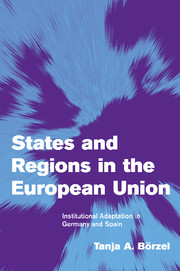Book contents
- Frontmatter
- Contents
- List of figures
- List of tables
- Acknowledgements
- List of abbreviations
- Introduction
- Part I Europeanization and domestic institutional change: A historical institutionalist approach
- Part II Reinforcing cooperative federalism: Institutional adaptation to Europeanization in Germany
- 4 The Federal Republic of Germany as a model of cooperative federalism
- 5 The rinascimento of cooperative federalism: The impact of Europeanization on the territorial institutions of Germany
- 6 Conclusion
- Part III Transforming competitive regionalism: Institutional adaptation to Europeanization in Spain
- Part IV Sharing versus shifting the costs of adaptation: The Europeanization of environmental policy-making in Germany and Spain
- Conclusions: Toward convergence in Europe?
- Appendix: The major EU environmental policies of the policy study
- List of references
- Index
4 - The Federal Republic of Germany as a model of cooperative federalism
Published online by Cambridge University Press: 22 September 2009
- Frontmatter
- Contents
- List of figures
- List of tables
- Acknowledgements
- List of abbreviations
- Introduction
- Part I Europeanization and domestic institutional change: A historical institutionalist approach
- Part II Reinforcing cooperative federalism: Institutional adaptation to Europeanization in Germany
- 4 The Federal Republic of Germany as a model of cooperative federalism
- 5 The rinascimento of cooperative federalism: The impact of Europeanization on the territorial institutions of Germany
- 6 Conclusion
- Part III Transforming competitive regionalism: Institutional adaptation to Europeanization in Spain
- Part IV Sharing versus shifting the costs of adaptation: The Europeanization of environmental policy-making in Germany and Spain
- Conclusions: Toward convergence in Europe?
- Appendix: The major EU environmental policies of the policy study
- List of references
- Index
Summary
This chapter outlines the major formal and informal institutions of German federalism. In particular, it shows how the institutional culture of multilateral bargaining and consensus-seeking have induced the Länder to confront the centralization of their autonomous competencies by a cooperative strategy of cost-sharing. Rather than invoking constitutional conflict, they demanded a compensation for their power losses in the form of participatory rights in federal decision-making. This has allowed for a flexible redressing of the territorial balance of power.
Functional division of labor, strong bicameralism, and fiscal equalization as the major formal institutions of German federalism
The Federal Republic of Germany comes close to a prototype of cooperative federalism. Unlike dual or competitive federalism as seen in the United States, the German Federal State was never meant to accommodate territorial plurality. In the post-war German Constitution, the federal structure fulfills two major purposes. First, it provides a vertical dimension of separation of power. A powerful regional level of government was designed to prevent the re-emergence of a strong central state (Hesse 1962). Second, the federal structure was designed to ensure a certain uniformity of living conditions for all Germans, as demanded by the Sozialstaatsprinzip (welfare state principle) enshrined in Art. 20 I of the Grundgesetz (GG; Basic Law) (Böckenförde 1980). The three major formal institutions of the German federal system are designed to balance the normative prescriptions for decentralization (separation of powers) and centralization (uniform living conditions).
- Type
- Chapter
- Information
- States and Regions in the European UnionInstitutional Adaptation in Germany and Spain, pp. 45 - 52Publisher: Cambridge University PressPrint publication year: 2001



